Growing up in Vietnam, banh uot was always a staple in my household. Its delicate and subtle flavor, combined with its smooth and silky texture, made it a favorite snack and a perfect addition to many meals.
Banh uot is not only delicious food, but it also holds significant cultural importance in Vietnamese cuisine. It is a traditional dish that has been passed down from generation to generation, and its popularity has spread far beyond Vietnam’s borders. As someone who has grown up with banh uot, I believe it represents the rich culinary heritage of Vietnam and reflects the country’s love for simple yet flavorful dishes.
In this article, I hope to share my personal experience and knowledge of banh uot with you. From its history and regional variations to popular recipes and street food culture, I will guide you through everything you need to know about this beloved Vietnamese dish. So, let’s delve into the world of banh uot and discover why it has become a culinary icon in Vietnamese cuisine.
What is banh out?
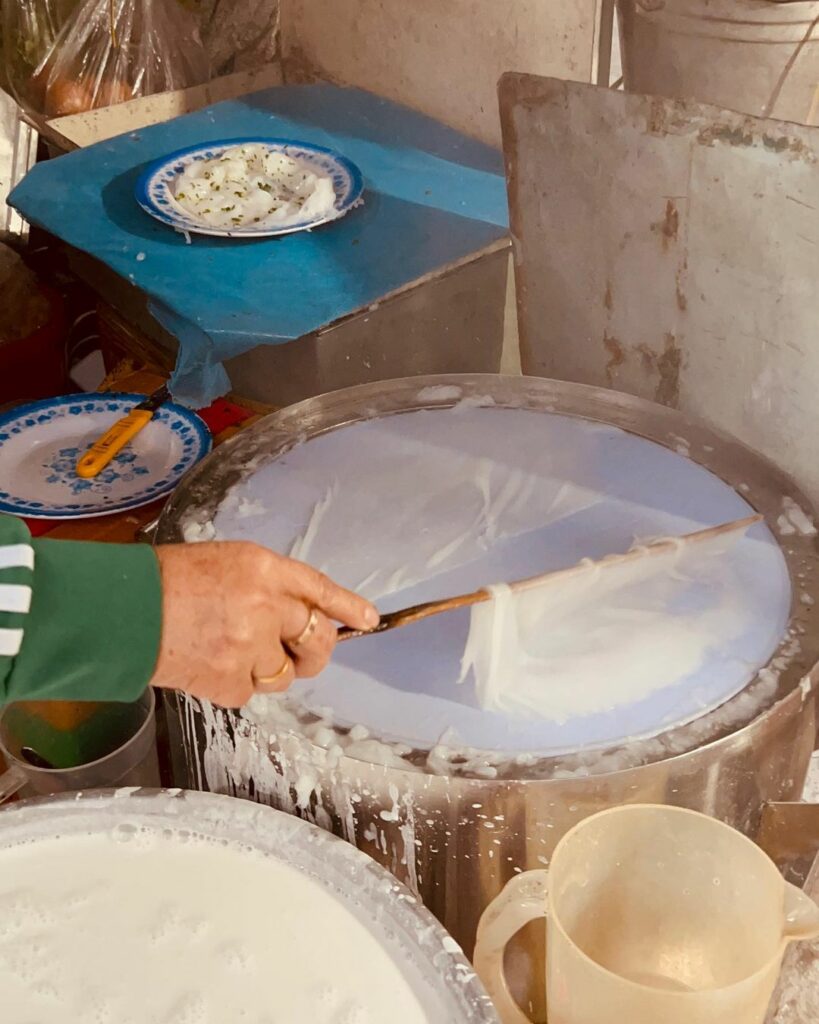
Banh uot, also known as Vietnamese banh uot, is a traditional dish that has been an integral part of Vietnamese cuisine for centuries. Made from a simple combination of rice flour and water, banh uot is a delicate and flavorful rice noodle roll that is enjoyed throughout Vietnam and beyond.
The origins of banh uot can be traced back to central Vietnam, where it is believed to have originated in the ancient city of Hue. Over time, banh uot has evolved and become a popular dish throughout the country, with each region adding its own unique flavors and ingredients to the dish.
In Vietnamese culture, banh uot is more than just a dish. It represents the country’s rich culinary heritage and reflects the Vietnamese people’s love for simple yet delicious food. Banh uot is often served during special occasions and festivals, such as weddings and lunar new year celebrations, and is also a staple in everyday meals.
Despite its humble origins, banh uot has become a culinary icon in Vietnamese cuisine, and its cultural significance is undeniable.
In this article, I will explore the definition and origin of banh uot, its historical background and evolution, and its cultural importance in Vietnamese cuisine. So, let’s delve into the world of Vietnamese banh uot and discover why it is so beloved by the Vietnamese people.
Read more: Top 15+ Diverse Vietnamese Breakfast Dishes You Need to Know
Banh uot recipe
Banh uot recipe is a classic Vietnamese dish that is perfect for any occasion. Here is a simple and easy-to-follow recipe to make delicious banh uot at home.
It is important to have a steamer and a piece of cloth to make banh uot. The cloth should be thin and smooth, such as a cotton or linen tea towel.
Cooking note
- Yield: 12 Banh uot rolls
- Prep time: 10 minutes
- Cook time: 30 minutes
- Total time: 40 minutes
- Course: Main Course
- Cuisine: Vietnamese
Equipment
- Steamer
- Thin, smooth cloth (such as a cotton or linen tea towel)
- Mixing bowl
- Measuring cups and spoons
- Whisk or fork
- Ladle or small cup
Ingredients
- 1 cup of rice flour
- 1 tablespoon of tapioca flour
- 1/2 teaspoon of salt
- 2 cups of water
- Vegetable oil (for brushing)
With this banh uot recipe, you can enjoy this classic Vietnamese dish in the comfort of your own home. It’s perfect for a light snack, appetizer, or even a main course. Give it a try and enjoy the delicious flavors of Vietnamese cuisine!
How to make banh out?
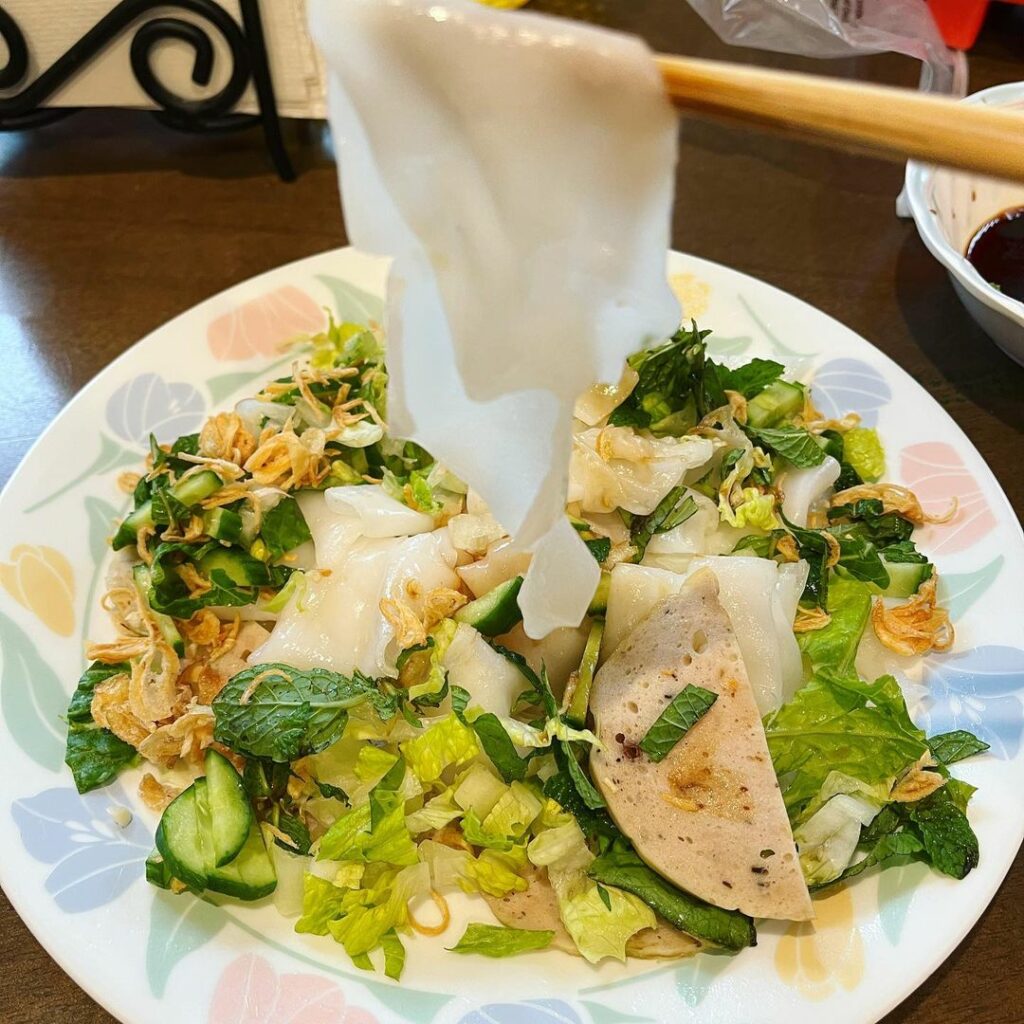
I’ll show you how to make banh uot. Follow me:
- In a mixing bowl, combine the rice flour, tapioca flour, and salt. Whisk together to combine.
- Slowly pour in the water while whisking until a smooth batter forms.
- Bring a pot of water to a boil and place the steamer on top.
- Cut the cloth into 8-inch squares and brush lightly with oil.
- Ladle a small amount of the batter onto the center of the cloth (about 2 tablespoons) and spread it evenly with the back of a spoon.
- Cover the pot with the steamer lid and steam the banh uot for 1–2 minutes, or until it becomes translucent and easily lifts from the cloth.
- Carefully remove the banh uot from the cloth with a spatula and place it on a plate.
- Repeat the process with the remaining batter, brushing the cloth with oil as needed.
- Serve the banh uot with your choice of dipping sauce, herbs, and toppings.
That’s it! With these simple steps, you can make delicious banh uot at home. It’s a fun and easy way to enjoy a traditional Vietnamese dish and impress your friends and family with your culinary skills.
Table of nutrient facts of banh uot
Here is a table of nutrient facts for banh uot, including the calories in banh uot:
| Nutrient | Amount |
| Calories | 35 |
| Total Fat | 0.2g |
| Sodium | 50,g |
| Total Carbohydrate | 7.9g |
| Dietary Fiber | 0.2g |
| Sugars | 0.1g |
| Protein | 0.6g |
| Calcium | 0.5% |
| Iron | 0.8% |
| Potassium | 0.5% |
It’s important to note that these nutrient values may vary depending on the specific recipe and ingredients used to make banh uot. However, in general, banh uot is a low-calorie and low-fat dish, making it a healthy and nutritious addition to your diet.
Common variations of banh out
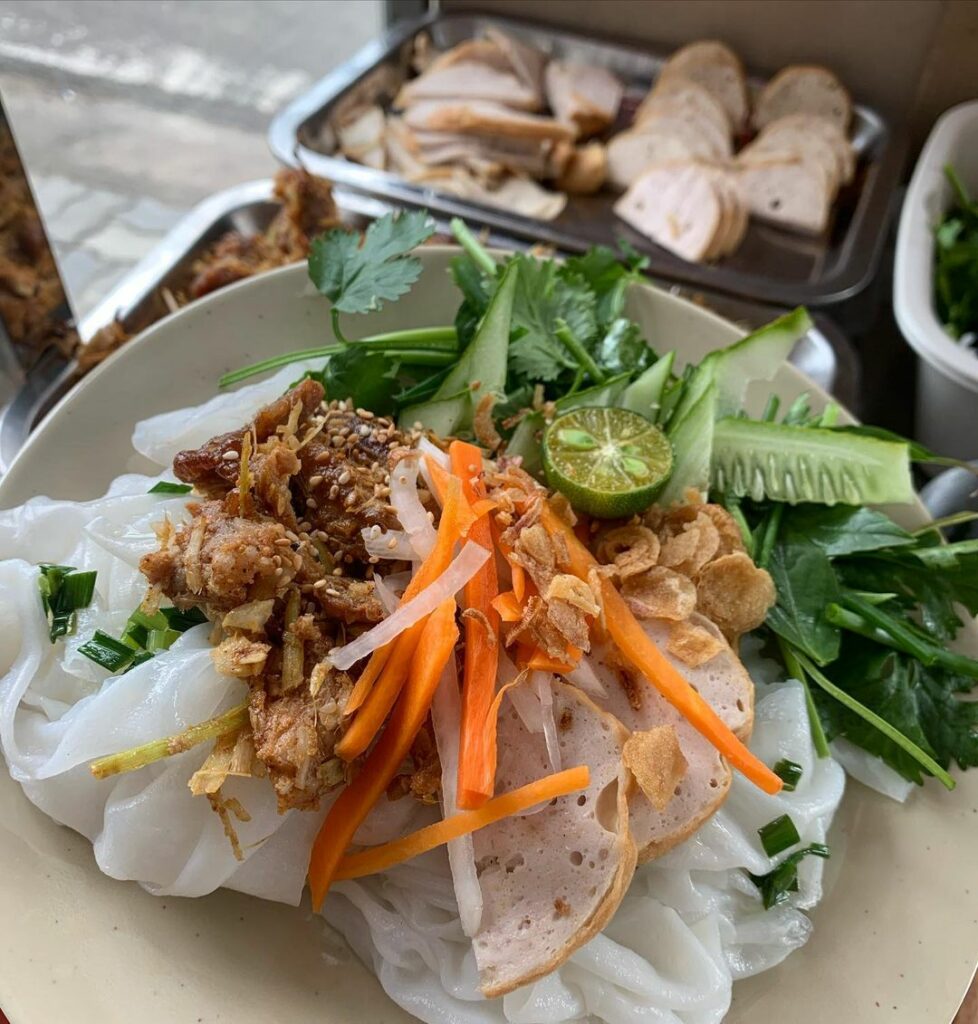
Banh uot, or Vietnamese rice noodle rolls, come in many delicious variations that showcase the versatility and creativity of Vietnamese cuisine. Here are five common variations of Banh ươt that you can find in Vietnam and Vietnamese restaurants around the world:
Banh uot cha lua
This variation of banh uot cha lua is banh ươt features a slice of cha lua, a type of Vietnamese pork sausage, wrapped inside the rice noodle roll. It is often served with fresh herbs, lettuce, and a dipping sauce made with fish sauce, sugar, lime juice, and chili.
Banh uot thit nuong
Banh uot thit nuong is made with grilled pork that is marinated in a sweet and savory sauce. The rice noodle rolls are served with grilled pork, fresh herbs, lettuce, and a dipping sauce that typically includes fish sauce, sugar, lime juice, and garlic.
These are just a few of the many variations of banh uot that you can enjoy. Each variation showcases the unique flavors and ingredients of Vietnamese cuisine, making banh uot a delicious and versatile dish.
Substitute ingredients for making banh uot
If you are unable to find some of the ingredients to make banh uot, there are several substitutes that you can use to achieve a similar result. Here are some substitutes for the main ingredients:
- Rice flour: If you cannot find rice flour, you can use all-purpose flour or cornstarch instead. However, the texture and flavor of the banh uot may be slightly different.
- Tapioca flour: Tapioca flour can be substituted with cornstarch or potato starch, which will give a similar texture to the rice noodle rolls.
- Thin, smooth cloth: If you don’t have a thin, smooth cloth to steam the banh uot, you can use parchment paper or plastic wrap instead.
- Dipping sauce: The dipping sauce for banh uot typically includes fish sauce, sugar, lime juice, and chili. If you don’t have these ingredients, you can substitute them with soy sauce, honey, lemon juice, and paprika or cayenne pepper.
It’s important to note that using substitutes may affect the overall taste and texture of the banh uot. However, with a little bit of creativity and experimentation, you can still enjoy this delicious Vietnamese dish even if you don’t have all the traditional ingredients on hand.
What to serve with banh uot?
Banh uot in Vietnamese is a versatile dish that can be eaten in many different ways. Here are a few suggestions for how to enjoy banh uot:
- With dipping sauce: Banh uot is typically served with a dipping sauce made with fish sauce, sugar, lime juice, and chili. Dip the rice noodle roll in the sauce to add a delicious burst of flavor.
- With herbs and vegetables: Banh uot can be served with a variety of fresh herbs and vegetables, such as mint, cilantro, lettuce, and bean sprouts. These ingredients add a refreshing and healthy element to the dish.
- With grilled meat or seafood: Banh uot can also be served with grilled meat or seafood, such as pork, beef, shrimp, or squid. The grilled meat adds a smoky and savory flavor that complements the delicate rice noodle roll.
- Wrapped around a spring roll: Banh uot can be used as a wrapper for a spring roll, which is typically filled with shrimp, pork, herbs, and vegetables. This makes for a delicious and portable snack or appetizer.
These are just a few suggestions for how to enjoy banh uot. The dish is highly versatile, and you can experiment with different flavors and ingredients to create your own unique and delicious combinations.
What is the difference between banh cuon and banh out?
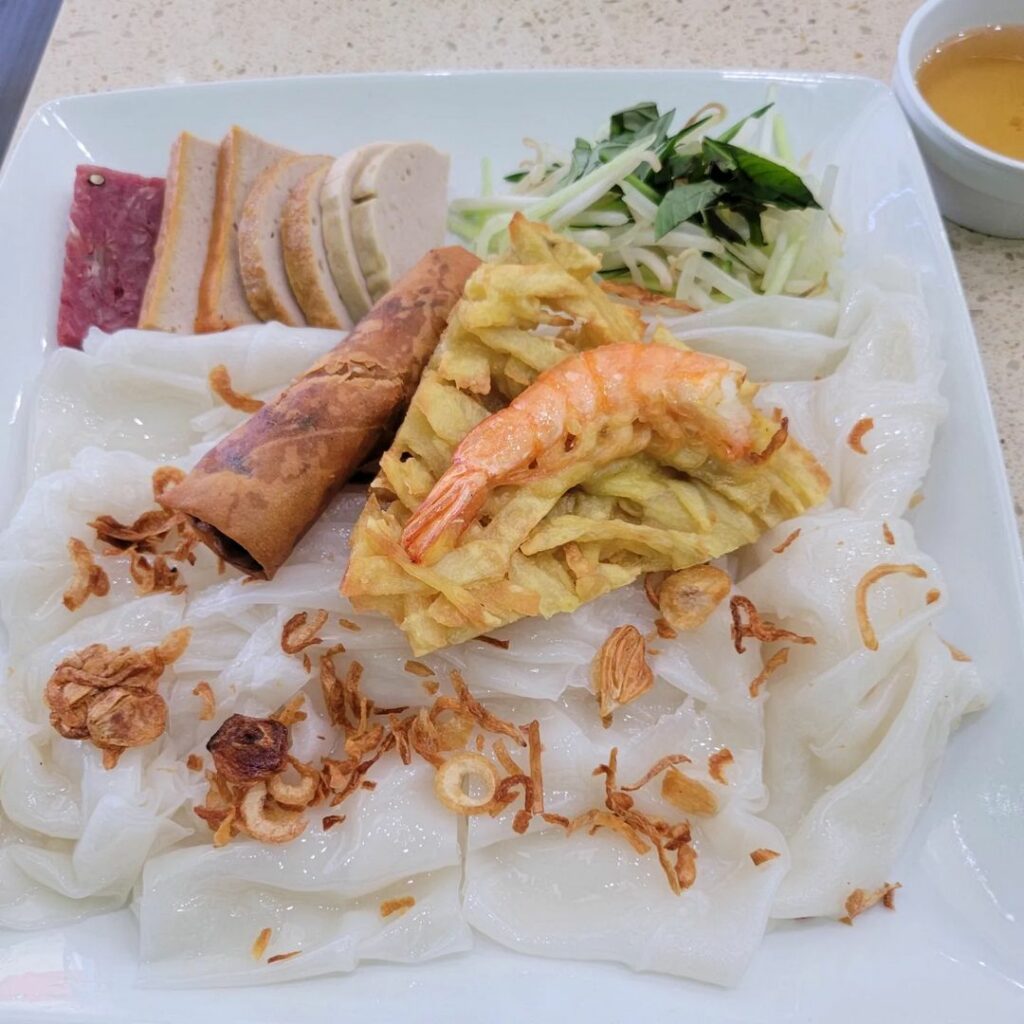
Banh cuon vs banh uot are two traditional Vietnamese dishes made from rice flour, but they have some notable differences that set them apart.
- Banh cuon is a steamed rice noodle roll that is typically filled with a mixture of ground pork, wood ear mushrooms, and shallots. The rice batter is spread thinly over a cloth that is stretched over a pot of boiling water, then the filling is added, and the roll is steamed until cooked. Banh cuon has a soft and chewy texture and is often served with a dipping sauce made with fish sauce, vinegar, sugar, and chili.
- On the other hand, banh uot is a rice noodle roll that is made by spreading a thin layer of rice batter over a cloth and steaming it until cooked. Banh uot is usually served with a variety of accompaniments, such as herbs, vegetables, meat, or seafood, and a dipping sauce. Banh uot has a delicate and silky texture and is often used as a wrapper for other ingredients, such as spring rolls.
The main differences between banh cuon and banh uot are in their fillings and texture. Banh cuon is filled with ground pork and mushrooms and has a soft and chewy texture, while banh uot is typically served with accompaniments and has a delicate and silky texture. Both dishes are delicious and popular in Vietnamese cuisine and offer a unique and tasty culinary experience.
How to eat banh uot?
Banh uot, a traditional Vietnamese dish made from rice flour, is typically served in a variety of ways with different dipping sauces and accompaniments. Here are some traditional ways of serving and eating Banh uot, as well as some tips on the etiquette of enjoying this delicious dish in Vietnamese culture.
Traditional ways of serving and eating banh uot
- Banh uot can be served on a plate or in a basket, accompanied by a dipping sauce and a variety of fresh herbs, such as mint, cilantro, and Thai basil.
- Banh uot can be served with grilled meat or seafood, such as pork, beef, shrimp, or squid.
- Banh uot can also be sliced into thin strips and added to a noodle salad with other ingredients like carrots, cucumbers, and peanuts.
- Banh uot can be used as a wrapper for spring rolls or other ingredients, such as grilled pork and shrimp.
Different dipping sauces and accompaniments to banh uot
- The traditional dipping sauce for Banh uot is made with fish sauce, sugar, lime juice, and chili.
- Banh uot can be accompanied by a variety of fresh herbs and vegetables, such as lettuce, bean sprouts, and sliced cucumbers.
Etiquette of eating banh uot in Vietnamese culture
- It is customary to share banh uot with others at the table, as it is often served in a communal style.
- Banh uot is typically eaten with chopsticks and a spoon, with the spoon used to scoop up the dipping sauce and the chopsticks used to pick up the banh uot and other accompaniments.
- When eating banh uot, it is important to avoid making loud noises or slurping sounds, as this is considered impolite in Vietnamese culture.
Banh uot is a versatile and delicious dish that can be enjoyed in many different ways. Whether you’re eating it on its own, with grilled meat or seafood, or as a wrapper for spring rolls, banh uot is a delightful and satisfying dish that is sure to please your taste buds. Remember to follow the traditional etiquette when eating banh uot in Vietnamese culture to fully appreciate the experience.
Common mistakes when making banh uot
Making banh uot can be a bit tricky, and there are a few common mistakes that people often make when trying to make this delicate dish. Here are some common mistakes and tips to fix them:
Mistake #1: The rice batter is too thick or too thin.
- If the rice batter for banh uot is too thick, it will be difficult to spread it evenly over the cloth, and the resulting rice noodle rolls will be too thick and gummy. If the batter is too thin, it will be difficult to peel the rice noodle rolls from the cloth without tearing them.
- To fix this, make sure to measure the ingredients accurately and follow the recipe instructions carefully. If the batter is too thick, add a little bit of water to thin it out. If it’s too thin, add a little bit more rice flour to thicken it.
Mistake #2: The cloth is not thin and smooth enough.
- Using a cloth that is too thick or textured can result in rice noodle rolls that are uneven and not translucent enough.
- To fix this, use a thin and smooth cloth, such as a cotton or linen tea towel. Make sure to brush the cloth lightly with oil to prevent the rice batter from sticking.
Mistake #3: The banh uot sticks to the cloth.
- If the rice noodle rolls stick to the cloth, they can tear and become difficult to remove.
- To fix this, make sure to brush the cloth with enough oil to prevent sticking. You can also try using parchment paper or plastic wrap instead of cloth.
Mistake #4: Overcooking or undercooking the banh uot.
- Overcooking the rice noodle rolls can make them too soft and mushy, while undercooking can make them too chewy and tough.
- To fix this, make sure to steam the banh uot for the appropriate amount of time, which is typically 1–2 minutes. The rice noodle rolls should be translucent and easily lift from the cloth when they are done.
By avoiding these common mistakes and following these tips, you can make delicious and perfect banh uot every time.
Where can eat banh uot in US?
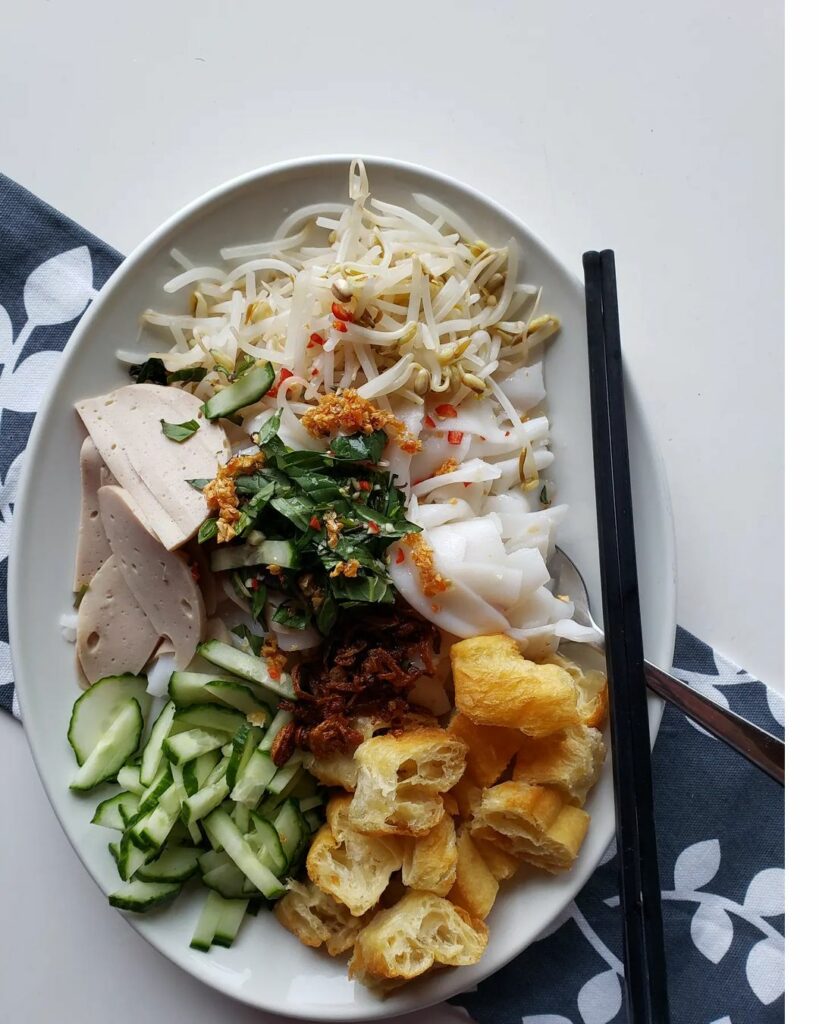
If you’re looking to enjoy banh uot in the United States, there are many Vietnamese restaurants that serve this delicious dish. Here are a few ways to find Banh uot near you:
- Search online: You can search for “banh uot near me” on search engines like Google or Yelp to find Vietnamese restaurants in your area that serve banh uot. You can also check restaurant review websites to see what other customers recommend.
- Pho Bac in Seattle, WA: This restaurant serves banh uot as part of their breakfast menu, and it’s a must-try dish. The rice noodle rolls are served with a side of pork sausage, grilled pork, and a dipping sauce.
- Banh Mi & Che Cali in Westminster, CA: This restaurant serves banh uot as a snack or appetizer, and it’s a popular dish among their customers. The rice noodle rolls are served with grilled pork and a dipping sauce.
- Huong Lan Sandwiches in San Jose, CA: This restaurant is a local favorite for banh uot, which is served with a variety of accompaniments, such as grilled pork, cha lua, and fresh herbs.
- Banh uot Tan Dinh in San Diego, CA: Lo Banh Cuon Tan Dinh serves the best banh uot and banh cuon in San Diego according to a satisfied customer. While the restaurant does not offer dine-in services, customers can still enjoy their food by picking it up. Additionally, they provide cha, veggies, and fish sauce, allowing customers to make their own plate at home.
- Check out Vietnamese communities: Many Vietnamese communities in the United States have their own restaurants and food markets that serve traditional dishes like banh uot. You can search online for Vietnamese communities near you and see if there are any restaurants that serve banh uot.
- Attend food festivals or events: Many cities in the United States hold food festivals or events that feature Vietnamese cuisine. These events are a great way to sample different dishes, including banh uot, and discover new restaurants in your area.
How much is a plate of banh uot?
The cost of a plate of banh uot can vary depending on the restaurant and location. In general, the price range for banh uot in Vietnamese restaurants in the US is usually between $7 to $15, depending on the variation and accompanying ingredients.
However, some high-end restaurants may charge more for banh uot that is made with premium ingredients or served with expensive accompaniments. It’s always a good idea to check the menu or ask the server for the price before ordering to avoid any surprises.
What is the best way to store leftover banh uot?
The best way to store leftover banh uot is to wrap it tightly in plastic wrap or aluminum foil and refrigerate it. It’s important to store it properly to prevent it from drying out or becoming hard.
You can also store the banh uot in an airtight container or resealable plastic bag.
FAQs
Is banh uot gluten-free?
Banh uot is typically gluten-free as it is made from rice flour, which does not contain gluten. However, it’s important to check the ingredients to ensure that there are no additional ingredients that may contain gluten.
What is the texture of banh uot?
Banh uot has a delicate and silky texture, similar to a rice noodle.
How can I fix banh uot if it turns out too thick or too thin?
If the batter for banh uot is too thick, add a little bit of water to thin it out. If it’s too thin, add a little bit more rice flour to thicken it.
Can banh uot be made ahead of time and reheated?
Yes, banh uot can be made ahead of time and reheated. Store it properly in the refrigerator, and reheat it by steaming it for a few minutes until it is heated through and pliable again.
Can banh uot be used as a wrapper for spring rolls?
Yes, banh uot can be used as a wrapper for spring rolls. It’s a popular way to serve banh uot in Vietnamese cuisine.
Can I make banh uot vegetarian or vegan?
Yes, banh uot can be made vegetarian or vegan by using vegetable broth or water instead of meat broth and omitting any meat or seafood toppings.
How can I make banh uot more flavorful?
You can add more flavor to banh uot by using flavored oils or adding herbs and spices to the batter. You can also serve it with flavorful dipping sauces and toppings.
Can I add different herbs or spices to banh uot?
Yes, you can add different herbs and spices to banh uot to enhance its flavor. Popular options include cilantro, mint, and green onions.
Can banh uot be frozen?
Yes, banh uot can be frozen for later use. Wrap it tightly in plastic wrap or aluminum foil, and store it in the freezer for up to a month.
Can I make banh uot without a steamer?
It’s possible to make banh uot without a steamer by using a large pot of boiling water and a colander or mesh sieve. Place the colander or sieve over the pot, and pour the rice batter onto the surface. Cover and steam for a few minutes until the banh uot is cooked.
Conclusion
Overall, banh uot is a traditional Vietnamese dish made from rice flour that has become popular around the world. Banh uot is a versatile dish that can be enjoyed in many different ways, whether as a snack, an appetizer, or a main dish.
Throughout this article, we have explored the definition and origin of Banh uot, its historical background and evolution, its cultural significance in Vietnamese cuisine and culture, as well as it’s nutritional value and cooking methods. We have also discussed common mistakes to avoid when making Banh uot and provided tips for fixing them, as well as some famous versions of this dish in Vietnam and popular places to try it in the US.
Banh uot is a delicious and unique dish that offers a taste of Vietnamese culture and cuisine. Whether you are a fan of Vietnamese food or a curious foodie looking to try something new, Banh uot is definitely worth trying. So, why not give it a go and discover the delights of this wonderful dish for yourself?
Try other breakfast:
- Bo Ne (Vietnamese Steak and Eggs) Recipe
- Shrimp Noodle Soup (Banh Canh Cua Tom)
- How to Make Xoi (Vietnamese Sticky Rice) in Rice Cooker?
- Hu Tieu Nam Vang Noodles
- Bo Kho (Vietnamese Beef Stew)
- Mien Ga
- Vietnamese Banh Beo Recipe
- Vietnamese Banh Bot Loc with Shrimp and Pork
- Banh Duc Nong: A Delicious Vietnamese Hot Rice Cake